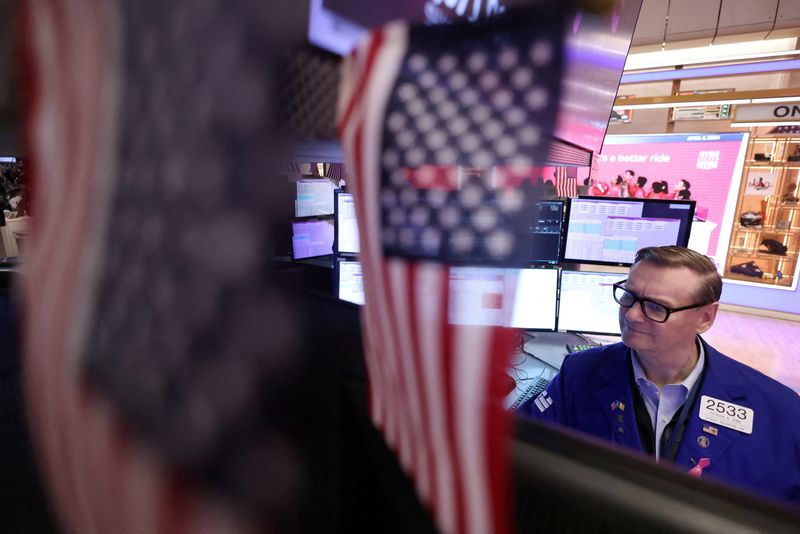A look at the day ahead in U.S. and global markets from Mike Dolan
With Middle East anxiety still brewing in the background, the red hot U.S. retail readout for March has underlined the sheer strength of the economic expansion there and is super-charging the dollar around the world.
Against Tuesday's news of a spluttering March for China's economy, and a surprising rise in British jobless during the month, the exceptional U.S. performance stands out yet again and has catapulted the dollar to new highs for the year.
China's first-quarter GDP annual growth of 5.3% did surpass expectations but March industry and retail growth missed forecasts, new home prices fell at their fastest pace in eight years and property investment fell almost 17% year-on-year.
And even though Wall St stocks indexes were side-swiped again on Monday by a mix of the interest rate implications of such brisk growth, heightened geopolitical tensions and a tepid earnings season outlook, the greenback is building a head of steam.
Aided by scaled-back Federal Reserve rate cut expectations while pressure builds on other central banks to ease first, the dollar's main index hit a five-month high on Tuesday and has now gained 4% in just six weeks.
The euro, China's offshore yuan and sterling hit their weakest levels against the buck since November while the Japan's yen skidded to new 34-year low of 154.60 per dollar. Currency volatility gauges hit their highest in more than two months.
Monday's news of a surprise March U.S. retail sales surge saw economists revise up their first-quarter U.S. economic growth estimates to just under 3% annualised. Morgan Stanley (NYSE:MS) raised its Q1 gross domestic product growth estimate to 2.7% from 2.4% and against a standing consensus forecast of 2.1%. The Atlanta Fed's 'GDPNow' real time estimate is running at 2.8%.
The figures reinforced the 'no landing' economic scenario touted by many investors and drew caution from Fed officials and jarring interest rate markets yet again.
"The worst thing to do is act urgently when urgency is not required," said San Francisco Fed boss Mary Daly, one of 19 U.S. central bankers who set monetary policy.
Fed futures now don't see a first rate cut this year until September.
With the International Monetary Fund's Spring meeting getting underway in Washington this week, Fed Chair Jerome Powell is due to speak on Tuesday - as is European Central Bank head Christine Lagarde and Bank of England governor Andrew Bailey.
The IMF also releases its updated World Economic Outlook later on Tuesday and markets will keenly watch its forecasts for U.S. growth for this year and next.
In the meantime, March U.S. industrial production and housing starts are the next big numbers in the data diary.
The upshot is a restive U.S. Treasury market, where 10-year Treasury yields hit 4.66% on Monday for the first time since November and held those gains today. Treasury volatility gauges hit their highest since Jan. 5.
With the first quarter U.S. corporate earnings season kicking into gear, stock market volatility is on the rise again too. The VIX 'fear index' hit its highest of the year on Tuesday too at 19.56 - coincidentally the average of the past 35 years since the index's inception.
Although a Goldman Sachs (NYSE:GS) beat on Monday lifted its stock and contrasted to a shaky start to the season for the big banks, the aggregate annual profit growth estimate for S&P500 companies has fallen to 2.7% for Q1 from as much as 5% at the start of the month and more than 7% at the start of the year.
Bank of America (NYSE:BAC) and Morgan Stanley are among the big names reporting later on Tuesday.
The mix of rate worries, earnings and geopolitics saw the S&P500 lose more than 1% again on Monday to its lowest in almost two months, although futures were steadier ahead of today's bell. The Russell 2000 of small cap stocks fell 1.4% and is now negative for the year to date.
Bourses across Asia and Europe were down more than 1% on Tuesday too.
With Middle East tensions simmering, U.S. crude oil prices held steady about $85 per barrel. Gold prices slipped back further from Friday's record high.
Key diary items that may provide direction to U.S. markets later on Tuesday:
* US corporate earnings: Bank of America, Morgan Stanley, Bank of New York Mellon (NYSE:BK), Northern Trust (NASDAQ:NTRS), PNC, Omnicom, Johnson & Johnson (NYSE:JNJ), UnitedHealth (NYSE:UNH), United Airlines (NASDAQ:UAL), JB Hunt (NASDAQ:JBHT)
* German Chancellor Olaf Scholz meets with China's President Xi Jinping and Premier Li Qiang in Beijing
* US March industrial production, housing starts/permits. Canada March consumer price inflation
* International Monetary Fund releases World Economic Outlook

* Federal Reserve Chair Jerome Powell, Fed Vice Chair Philip Jefferson, New York Fed President John Williams and Richmond Fed chief Thomas Barkin all speak; European Central Bank President Christine Lagarde, ECB policymaker and Bundesbank chief Joachim Nagel, ECB policymaker and Bank of Finland chief Olli Rehn all speak; Bank of England governor Andrew Bailey and BoE's next deputy governor for monetary policy Clare Lombardelli speak.
* US Treasury sells 12-month bills
(By Mike Dolan, editing by Ros Russell; mike.dolan@thomsonreuters.com)